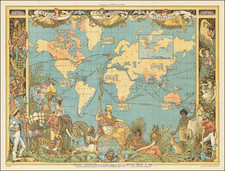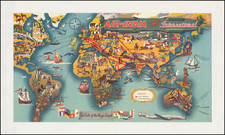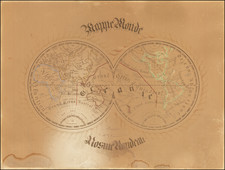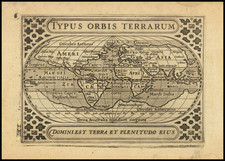Full color example of the Ruscelli's Carta Marina, based upon Gastaldi's map of 1548. Gastaldi's Carta Marina includes the earliest obtainable depictions of the California peninsula, is the earliest obtainable copperplate world map for collectors. Includes Gastaldi's belief in a continuous northern landmass, the isthmus reported by Verrazano in 1524, which closes the northern continents into as unbroken ring. The Asia-America connection was a standard concept, and one of which Gastaldi actively advocated. The joining of North America and Europe is unusual, resulting from two errors. In the east, Gastaldi depicts Greenland as an outgrowth of Scandinavia, based upon Waldseemuller. In the west, Gastaldi follows Verrazano's model of North America. On the Atlantic coast by Gastaldi notes a green mountain and a large, unnamed cape pointing upwards. This cape, based upon Ramusio's' map of 1534, first appeared in Ribero's manuscript chart of 1529, as well as later works, such as Jode's North America. The cape is believed to be Cape Cod, as both the Ribero and Ramusio maps reflect the reconnaissance along the New England coast by Estavao Gomes, who is believed to have coasted the region. The writing's of Marco Polo are evident in Asia, with modern corrections. An interesting full color example. Dark clean plate image. Shirley 111.
Girolamo Ruscelli (1500-1566) was a cartographer, humanist, and scholar from Tuscany. Ruscelli was a prominent writer and editor in his time, writing about a wide variety of topics including the works of Giovanni Boccaccio and Francesco Petrarch, Italian language, Italian poetry, medicine, alchemy, and militia. One of his most notable works was a translation of Ptolemy’s Geographia which was published posthumously.
There is limited information available about Ruscelli’s life. He was born in the Tuscan city of Viterbo to a family of modest means. He was educated at the University of Padua and moved between Rome and Naples until 1548, when he moved to Naples to work in a publishing house as a writer and proofreader. He remained in the city until his death in 1566.










![Western Hemisphere [and] Eastern Hemisphere](https://storage.googleapis.com/raremaps/img/small/90387.jpg)



![[Early Photographic Facsimile of the 1529 Ribero World Map]](https://storage.googleapis.com/raremaps/img/small/67279.jpg)